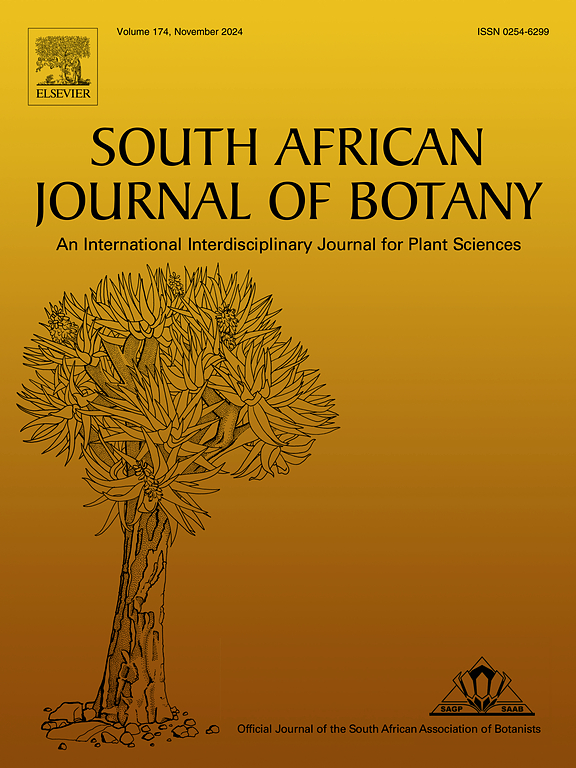野生植物剑兰的花形态和香味特征研究
IF 2.7
3区 生物学
Q2 PLANT SCIENCES
引用次数: 0
摘要
剑兰是一种商业上重要的球茎观赏作物,有许多品种,展示了广泛的颜色和形式,但它缺乏香味。它通常用作切花,用于花园展示和盆栽植物。剑兰属的芳香品种,原属剑兰,因其有香味的星形花而受到重视。然而,这个物种的香味的复杂性是高度未开发的。本研究重点研究了剑兰的花形态特征和香气特征,旨在确定其育种行为,为剑兰香型品种的开发提供依据。形态特征表明,该植物叶绿,花白色,喉部有褐红色斑点,繁殖效率高。早晨花药开裂,花药开裂有纵裂,三裂柱头在受花期展开。花粉粒是有活力的单胞体,具有异极取向和微网状外壁,适合作为花粉亲本。在三个不同的花开放阶段(芽、半开放和完全开放)进行香味对比分析,发现在花的整个生命周期中存在55种挥发性有机化合物(VOCs)。通过热图聚类,将55种VOCs分为4个聚类,表明挥发性多样性的流行程度。桉树油在半开花时含量最高,含苞待放期含苞待放期含苞待放期含苞待放期含苞待放期含苞待放期含苞待放期含苞待放期含苞待放期含苞待放期含苞待放。主成分分析的结果表明,前两种成分贡献了84%的总香味变化。本研究确定了产生香味的主要挥发性有机化合物,并促进了进一步的研究,如鉴定潜在基因和将这些香味基因渗入理想的背景,从而开发出有香味的剑兰品种。本文章由计算机程序翻译,如有差异,请以英文原文为准。
Exploring floral morphology and scent profile of Gladiolus murielae: a wild crop relative for fragrance introgression
Gladiolus is a commercially significant bulbous ornamental crop with numerous varieties showcasing a wide range of colours and forms, yet it lacks fragrance. It is commonly used as cut flower, for garden display and as potted plant. The fragrant species of gladiolus originally Gladiolus murielae is valued for its scented star shaped flowers. However, the complexity of fragrance in this species is highly unexplored. The study emphasizes the floral morphological characterization and fragrance profiling of G. murielae, aiming to establish its breeding behavior to utilize in the development of fragrant gladiolus cultivars. Morphological characterization revealed that the plants have grassy foliage, and the flowers are white in color with a maroon blotch on the throat with good multiplication efficiency. Anthesis and anther dehiscence occur in the morning, anther dehisces with longitudinal slit, and the trifid stigma unfurls upon receptivity. The pollen grains are viable, monad, with a paraisopolar orientation, and featured the microreticulate exine, and are suitable as pollen parents. Comparative fragrance profiling at three different flower opening stages (bud, half open and full open) recognized the presence of 55 volatile organic compounds (VOCs) throughout the floral lifespan. Clustering through heat map divided the 55 VOCs into four clusters indicating the prevalence of volatile diversity. Cineole peaked at half bloom, cis-Sabinene hydrate and methyl salicylate were abundant in bud stage, and methyl benzoate appeared exclusively at full bloom. Results of the PCA specified that the first two components contributed for 84 % of the total fragrance variation. This study identifies the major VOCs that are responsible for fragrance and facilitates further studies like identification of underlying genes and the introgression of those fragrant genes into desirable backgrounds, leading to the development of scented gladiolus varieties.
求助全文
通过发布文献求助,成功后即可免费获取论文全文。
去求助
来源期刊

South African Journal of Botany
生物-植物科学
CiteScore
5.20
自引率
9.70%
发文量
709
审稿时长
61 days
期刊介绍:
The South African Journal of Botany publishes original papers that deal with the classification, biodiversity, morphology, physiology, molecular biology, ecology, biotechnology, ethnobotany and other botanically related aspects of species that are of importance to southern Africa. Manuscripts dealing with significant new findings on other species of the world and general botanical principles will also be considered and are encouraged.
 求助内容:
求助内容: 应助结果提醒方式:
应助结果提醒方式:


